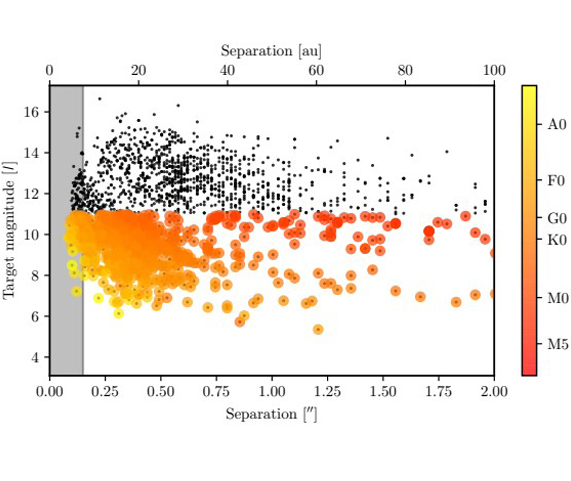KalAO the swift adaptive optics imager on 1.2m Euler Swiss telescope in La Silla, Chile
ABSTRACT
KalAO is a natural guide star adaptive optics (AO) imager to be installed on the second Nasmyth focus of the 1.2m Euler Swiss telescope in La Silla, Chile. The initial design of the system is inspired on RoboAO with modifications in order to operate in natural guide star (NGS) mode. KalAO was built to search for binarity in planet hosting stars by following-up candidates primarily from the TESS satellite survey. The optical design is optimised for the 450-900 nm wavelength range and is fitted with SDSS g,r,i,z filters. The system is designed for wavefront control down to I-magnitude 11 stars in order to probe the same parameter space as radial velocity instruments such as HARPS and NIRPS. The principal components of the system are an 11x11 10.9 cm sub-apertures Electron Multiplying CCD (EMCCD) Shack-Hartmann wavefront sensor, a 140 actuators Microelectromechanical systems (MEMS) deformable mirror, a fast tip/tilt mirror, and a graphics processing unit (GPU) powered glycol cooled real-time computer. It is designed to run at up to 1.8kHz in order to detect companions as close as the 150mas visible-light diffraction limit. The real-time adaptive optics control is using the CACAO software running on GPUs. The instrument is planned for commissioning early 2021 in Chile if the covid restrictions are lifted.
1. INTRODUCTION
KalAO is a new high-resolution high-cadence imager which will be installed on the 1.2m Swiss telescope Euler in Chile in early 2021. The primary goal of KalAO is to observe stars where a planet transit has been detected by the TESS satellite mission in order to search for additional stellar companions. The KalAO survey will target candidate and confirmed transiting planets to verify if they are located within a binary, with 80 nights on the Swiss telescope dedicated to this project over the next 2.5 years. It will also play a planet candidate vetting role in the TESS follow-up observations effort and possibly other surveys such as PLATO.
Using the detection yield of the TESS space mission1 simulated by 2, we derived the expected yield of stellar companions to TESS planet candidates (Fig. 1). To combine the detections with radial velocity characterisation (mainly using Coralie, HARPS, or NIRPS), the targets in the sample need to be bright enough. Stars fainter than magnitude 11 in I become more challenging for radial velocity follow-up. Binary stars with a separation smaller than 0.1” are expected to yield a strong radial velocity signal typical of short period binary stars. To reach such small separations on a 1.2m telescope we thus have to observe in the visible. These considerations on the science case thus result the following top requirements for KalAO:
-
AO down to I magnitude 11
-
Wavelength range: 450–900 nm
-
Diffraction limited FWHM: 0.11” @ 635 nm
-
Minimal field of view: 10”
-
> 15% Strehl in z band

Figure 1. Simulated TESS stellar contaminants yield, based on the sample from Ref.
The greyed area represent the inaccessible parameter space due to the diffraction limit at 0.15”.
Black dots are contaminants around stars fainter than I mag 11
and thus too faint for good performance adaptive optics and radial velocity.
Для продолжения чтения вы можете скачать полную версию материала по ссылке ниже